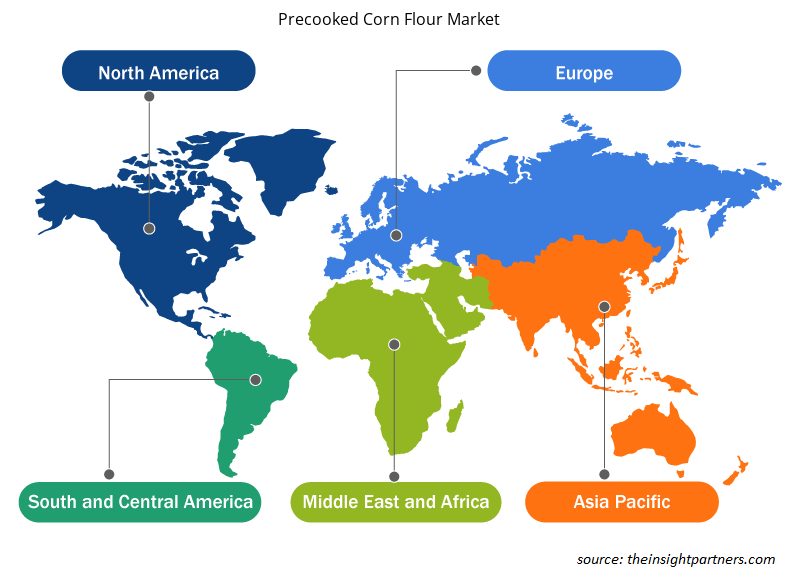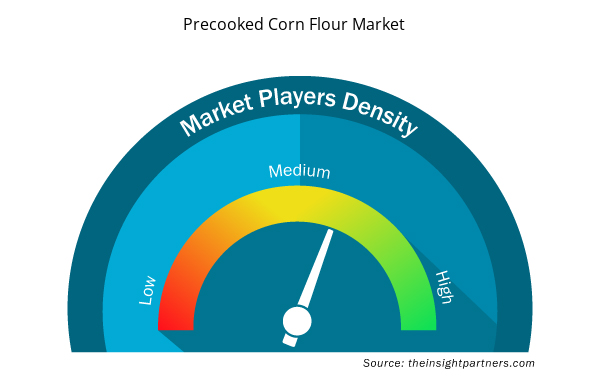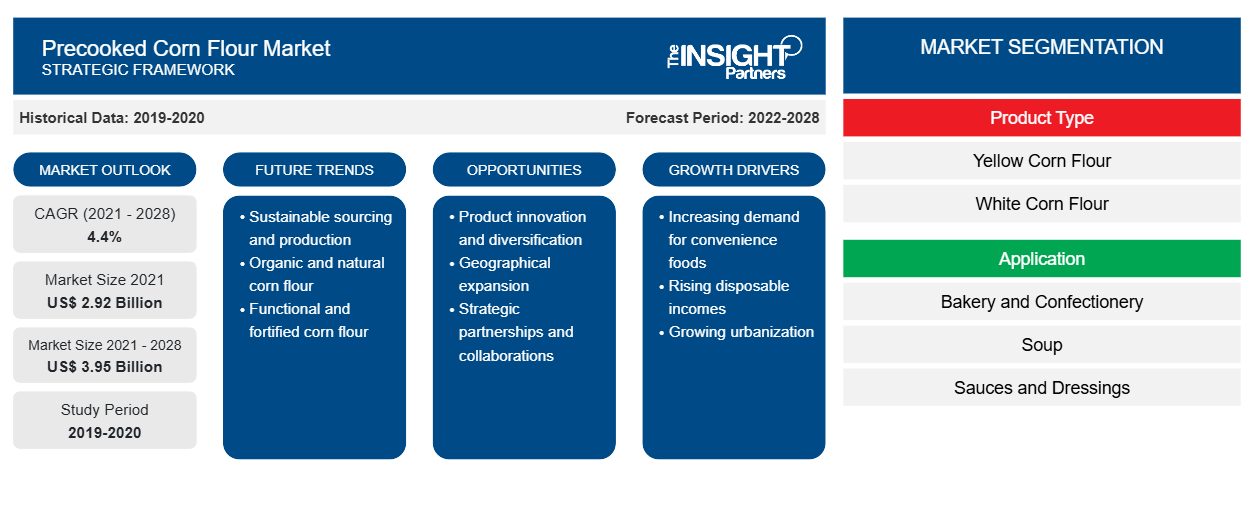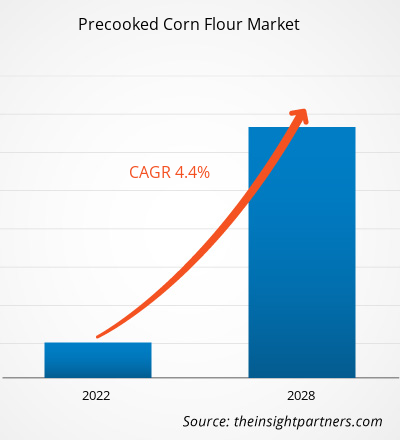El mercado de harina de maíz precocida se valoró en US$ 2.918,78 millones en 2021 y se proyecta que alcance los US$ 3.953,67 millones en 2028; se espera que crezca a una CAGR del 4,4% de 2021 a 2028.
La harina de maíz precocida no contiene gluten y es un ingrediente esencial para hacer tortillas , tamales y otros platos mexicanos. La adopción de la cocina mexicana en todo el mundo está aumentando el consumo de harina de maíz precocida.
En 2020, Asia Pacífico dominó el mercado mundial de harina de maíz precocida y se espera que continúe su dominio durante el período de pronóstico. La creciente conciencia relacionada con los beneficios para la salud y el rico perfil nutricional que ofrecen los productos preparados a partir de harina de maíz precocida están impulsando el crecimiento del mercado de harina de maíz precocida en toda la región. Además, el aumento de los ingresos disponibles de las personas y el aumento de las aplicaciones de la harina de maíz precocida han llevado a una creciente demanda de harina de maíz precocida. Además, la creciente adopción y consumo de comida mexicana en países como Australia e India está impulsando la demanda de harina de maíz precocida.
Personalice este informe según sus necesidades
Obtendrá personalización en cualquier informe, sin cargo, incluidas partes de este informe o análisis a nivel de país, paquete de datos de Excel, así como también grandes ofertas y descuentos para empresas emergentes y universidades.
- Obtenga las principales tendencias clave del mercado de este informe.Esta muestra GRATUITA incluirá análisis de datos, desde tendencias del mercado hasta estimaciones y pronósticos.
Perspectivas del mercado
Demanda creciente de productos alimenticios sin gluten
El consumo excesivo de gluten puede provocar graves problemas de salud, como sensibilidad, alergia al trigo y enfermedad celíaca. Según la Organización Mundial de Gastroenterología (WGO), la enfermedad celíaca afecta a personas de todas las edades. Además, según el Instituto de Medicina Funcional, la incidencia de la enfermedad celíaca está aumentando un 7,5 % al año, y es más frecuente entre mujeres y niños. El aumento de la demanda de productos alimenticios sin gluten se debe a que cada vez hay más consumidores preocupados por la salud. Estos factores están impulsando la demanda de productos alimenticios sin gluten.
Información sobre el tipo de producto
Según el tipo de producto, el mercado de harina de maíz precocida se clasifica en harina de maíz amarillo, harina de maíz blanco y otros. En 2020, el segmento de harina de maíz amarillo dominó el mercado. El mayor uso de harina de maíz amarillo en aplicaciones de panadería impulsa la demanda de harina de maíz precocida. Se utiliza para hornear galletas debido a su textura suave y buenas características aglutinantes. Además, los minerales y vitaminas de la harina de maíz amarillo promueven su uso en una amplia gama de productos alimenticios nutritivos.
Los principales actores del mercado adoptan estrategias como fusiones y adquisiciones y lanzamientos de productos para expandir su presencia geográfica y su base de consumidores. Algunos de los actores clave que operan en el mercado de harina de maíz precocida son Archer Daniels Midland Company, Cargill Incorporated, Limagrain (Limagrain Ingredients), Agricor, Buhler, Favero Antonio SRL, Molino Peila SpA, SEMO Milling LLC, Bunge Limited y Gruma SAB de CV.Cargill Incorporated, Limagrain (Limagrain Ingredients), Agricor, Buhler, Favero Antonio SRL, Molino Peila SpA, SEMO Milling LLC, Bunge Limited, and Gruma S.A.B. de C.V.
Informe Destacado
- Tendencias progresivas en el mercado de harina de maíz precocida para ayudar a los actores a desarrollar estrategias efectivas a largo plazo
- Estrategias de crecimiento adoptadas por las empresas para asegurar el crecimiento en los mercados desarrollados y en desarrollo
- Análisis cuantitativo del mercado mundial de harina de maíz precocida de 2019 a 2028
- Estimación de la demanda de harina de maíz precocida en diversas industrias
- Análisis de Porter para ilustrar la eficacia de los compradores y proveedores que operan en la industria para predecir el crecimiento del mercado
- Desarrollos recientes para comprender el escenario competitivo del mercado y la demanda de harina de maíz precocida
- Tendencias y perspectivas del mercado junto con los factores que impulsan y restringen el crecimiento del mercado de harina de maíz precocida
- Comprender las estrategias que sustentan el interés comercial con respecto al crecimiento del mercado mundial de harina de maíz precocida, ayudando en el proceso de toma de decisiones
- Tamaño del mercado de harina de maíz precocida en varios nodos del mercado
- Descripción detallada y segmentación del mercado mundial de harina de maíz precocida, así como su dinámica industrial
- Tamaño del mercado de harina de maíz precocida en varias regiones con oportunidades de crecimiento prometedoras
El “Análisis del mercado global de harina de maíz precocida hasta 2028” es un estudio especializado y profundo de la industria de bienes de consumo con un enfoque especial en el análisis de tendencias del mercado global de harina de maíz precocida. El informe tiene como objetivo proporcionar una descripción general del mercado con una segmentación detallada del mercado. El mercado de harina de maíz precocida está segmentado en función del tipo de producto, la aplicación y la geografía. Según el tipo de producto, el mercado se clasifica en harina de maíz amarillo, harina de maíz blanco y otros. Según la aplicación, el mercado de harina de maíz precocida se segmenta en panadería y confitería, sopas, salsas y aderezos, comidas y alimentos listos para comer, bocadillos extruidos y otros. Según la geografía, el mercado de harina de maíz precocida está segmentado en cinco regiones principales: América del Norte, Europa, Asia-Pacífico, Medio Oriente y África, y América del Sur y Central.
Perspectivas regionales del mercado de harina de maíz precocida
Los analistas de Insight Partners explicaron en detalle las tendencias y los factores regionales que influyen en el mercado de harina de maíz precocida durante el período de pronóstico. Esta sección también analiza los segmentos y la geografía del mercado de harina de maíz precocida en América del Norte, Europa, Asia Pacífico, Oriente Medio y África, y América del Sur y Central.

- Obtenga datos regionales específicos para el mercado de harina de maíz precocida
Alcance del informe de mercado de harina de maíz precocida
| Atributo del informe | Detalles |
|---|---|
| Tamaño del mercado en 2021 | US$ 2.92 mil millones |
| Tamaño del mercado en 2028 | 3.950 millones de dólares estadounidenses |
| CAGR global (2021-2028) | 4,4% |
| Datos históricos | 2019-2020 |
| Período de pronóstico | 2022-2028 |
| Segmentos cubiertos | Por tipo de producto
|
| Regiones y países cubiertos | América del norte
|
| Líderes del mercado y perfiles de empresas clave |
|
Densidad de actores del mercado: comprensión de su impacto en la dinámica empresarial
El mercado de harina de maíz precocida está creciendo rápidamente, impulsado por la creciente demanda de los usuarios finales debido a factores como la evolución de las preferencias de los consumidores, los avances tecnológicos y una mayor conciencia de los beneficios del producto. A medida que aumenta la demanda, las empresas amplían sus ofertas, innovan para satisfacer las necesidades de los consumidores y aprovechan las tendencias emergentes, lo que impulsa aún más el crecimiento del mercado.
La densidad de actores del mercado se refiere a la distribución de las empresas o firmas que operan dentro de un mercado o industria en particular. Indica cuántos competidores (actores del mercado) están presentes en un espacio de mercado determinado en relación con su tamaño o valor total de mercado.
Las principales empresas que operan en el mercado de harina de maíz precocida son:
- Compañía Midland de Archer Daniels
- Cargill, Incorporada
- Limagrain (ingredientes de Limagrain)
- Agricultor
- Bühler
Descargo de responsabilidad : Las empresas enumeradas anteriormente no están clasificadas en ningún orden particular.

- Obtenga una descripción general de los principales actores clave del mercado de harina de maíz precocida
Perfiles de empresas
- Compañía Midland de Archer Daniels
- Cargill Incorporated
- Limagrain (ingredientes de Limagrain)
- Agricultor
- Bühler
- Favero Antoniop SRL
- Molino Peila SpA
- Fresado SEMO LLC
- Bunge limitada
- Gruma SAB de CV
- Análisis histórico (2 años), año base, pronóstico (7 años) con CAGR
- Análisis PEST y FODA
- Tamaño del mercado Valor/volumen: global, regional, nacional
- Industria y panorama competitivo
- Conjunto de datos de Excel


- Bioremediation Technology and Services Market
- Water Pipeline Leak Detection System Market
- Foot Orthotic Insoles Market
- Medical and Research Grade Collagen Market
- Industrial Valves Market
- Integrated Platform Management System Market
- Sexual Wellness Market
- Fishing Equipment Market
- Electronic Health Record Market
- Equipment Rental Software Market

Report Coverage
Revenue forecast, Company Analysis, Industry landscape, Growth factors, and Trends

Segment Covered
This text is related
to segments covered.

Regional Scope
North America, Europe, Asia Pacific, Middle East & Africa, South & Central America

Country Scope
This text is related
to country scope.
Preguntas frecuentes
In 2020, the extruded snacks segment accounted for the largest market share. Extruded snacks are being widely consumed in parties, small or large gatherings, entertainment centers, and various other places. In recent years, the consumers have become more cautious about their snacking habits and are increasingly preferring healthy extruded snacks. The consumption of healthy extruded snack products is expanding the scope precooked corn flour in the extruded snacks segment.
On the basis of application, extruded snacks is the fastest-growing segment. Extruded snacks are a type of snacking food prepared by the extrusion process. Raw materials like starch-rich materials (corn, potato flour, maize, wheat, rice, etc.) are first ground to the correct particle size, and then they are transformed into hot melt fluids or the dry mix. This mixture is passed through a pre-conditioner, in which other ingredients such as liquid sugar, fats, dyes, meats, or water are added depending on the target product. Steam is passed to start the cooking process, and the preconditioned mix is then pushed through an extruder to produce snacks.
In 2020, Asia-Pacific is the fastest-growing region in the global precooked corn flour market. Consumers in the Asia Pacific are becoming health-conscious day by day, resulting in the demand for gluten-free and organic products. Health-conscious consumers are focusing on healthy bakery products, aiding the precooked corn flour market in this region. Along with the rising popularity of Mexican cuisine, the healthier nutritional profile of tortillas has made them increasingly popular with younger populations across the region.
The major players operating in the global precooked corn flour market are Archer Daniels Midland Company; Cargill, Incorporated; Limagrain (Limagrain Ingredients); Agricor; Buhler; Favero Antonio SRL; Molion Peila SpA; Gruma; S.A.B. de C.V. and SEMO Milling LLC.
In 2020, Asia-Pacific accounted for the largest share of the global precooked corn flour market. The demand for extruded snacks is on the rise due to the increase in disposable income and the on-the-go snacking trend among the urban population due to the hectic lifestyle. The rapidly changing lifestyle of consumers, and the change in eating habits, have been driving the extruded snacks market in Asia Pacific. The region is witnessing a rise in single-person and dual-income-no-kids (DINK) households. Long working hours drive the consumer preference toward healthy snacking options over meals, driving the demand for convenient food and on-the-go food products. The increase in demand for such food products is leading to an increased demand for precooked corn flour as it is one of the essential ingredients used in producing various snack products.
In 2020, the yellow corn flour segment accounted for the largest market share. Yellow corn flour is a type of corn flour that is most commonly used compared to other types of flour, such as white corn flour and blue corn flour. It is extensively used for baking cornbread or as an addition to other flours. This type of flour is also used in making tortillas, muffins, and pancakes. Yellow corn flour is slightly sweeter than white and blue corn.
Trends and growth analysis reports related to Food and Beverages : READ MORE..
The List of Companies - Precooked Corn Flour Market
- Archer Daniels Midland Company
- Cargill, Incorporated
- Limagrain (Limagrain Ingredients)
- Agricor
- Buhler
- Favero Antoniop SRL
- Molion Peila SpA
- SEMO Milling LLC
- Gruma
- S.A.B. de C.V.
The Insight Partners performs research in 4 major stages: Data Collection & Secondary Research, Primary Research, Data Analysis and Data Triangulation & Final Review.
- Data Collection and Secondary Research:
As a market research and consulting firm operating from a decade, we have published and advised several client across the globe. First step for any study will start with an assessment of currently available data and insights from existing reports. Further, historical and current market information is collected from Investor Presentations, Annual Reports, SEC Filings, etc., and other information related to company’s performance and market positioning are gathered from Paid Databases (Factiva, Hoovers, and Reuters) and various other publications available in public domain.
Several associations trade associates, technical forums, institutes, societies and organization are accessed to gain technical as well as market related insights through their publications such as research papers, blogs and press releases related to the studies are referred to get cues about the market. Further, white papers, journals, magazines, and other news articles published in last 3 years are scrutinized and analyzed to understand the current market trends.
- Primary Research:
The primarily interview analysis comprise of data obtained from industry participants interview and answers to survey questions gathered by in-house primary team.
For primary research, interviews are conducted with industry experts/CEOs/Marketing Managers/VPs/Subject Matter Experts from both demand and supply side to get a 360-degree view of the market. The primary team conducts several interviews based on the complexity of the markets to understand the various market trends and dynamics which makes research more credible and precise.
A typical research interview fulfils the following functions:
- Provides first-hand information on the market size, market trends, growth trends, competitive landscape, and outlook
- Validates and strengthens in-house secondary research findings
- Develops the analysis team’s expertise and market understanding
Primary research involves email interactions and telephone interviews for each market, category, segment, and sub-segment across geographies. The participants who typically take part in such a process include, but are not limited to:
- Industry participants: VPs, business development managers, market intelligence managers and national sales managers
- Outside experts: Valuation experts, research analysts and key opinion leaders specializing in the electronics and semiconductor industry.
Below is the breakup of our primary respondents by company, designation, and region:

Once we receive the confirmation from primary research sources or primary respondents, we finalize the base year market estimation and forecast the data as per the macroeconomic and microeconomic factors assessed during data collection.
- Data Analysis:
Once data is validated through both secondary as well as primary respondents, we finalize the market estimations by hypothesis formulation and factor analysis at regional and country level.
- Macro-Economic Factor Analysis:
We analyse macroeconomic indicators such the gross domestic product (GDP), increase in the demand for goods and services across industries, technological advancement, regional economic growth, governmental policies, the influence of COVID-19, PEST analysis, and other aspects. This analysis aids in setting benchmarks for various nations/regions and approximating market splits. Additionally, the general trend of the aforementioned components aid in determining the market's development possibilities.
- Country Level Data:
Various factors that are especially aligned to the country are taken into account to determine the market size for a certain area and country, including the presence of vendors, such as headquarters and offices, the country's GDP, demand patterns, and industry growth. To comprehend the market dynamics for the nation, a number of growth variables, inhibitors, application areas, and current market trends are researched. The aforementioned elements aid in determining the country's overall market's growth potential.
- Company Profile:
The “Table of Contents” is formulated by listing and analyzing more than 25 - 30 companies operating in the market ecosystem across geographies. However, we profile only 10 companies as a standard practice in our syndicate reports. These 10 companies comprise leading, emerging, and regional players. Nonetheless, our analysis is not restricted to the 10 listed companies, we also analyze other companies present in the market to develop a holistic view and understand the prevailing trends. The “Company Profiles” section in the report covers key facts, business description, products & services, financial information, SWOT analysis, and key developments. The financial information presented is extracted from the annual reports and official documents of the publicly listed companies. Upon collecting the information for the sections of respective companies, we verify them via various primary sources and then compile the data in respective company profiles. The company level information helps us in deriving the base number as well as in forecasting the market size.
- Developing Base Number:
Aggregation of sales statistics (2020-2022) and macro-economic factor, and other secondary and primary research insights are utilized to arrive at base number and related market shares for 2022. The data gaps are identified in this step and relevant market data is analyzed, collected from paid primary interviews or databases. On finalizing the base year market size, forecasts are developed on the basis of macro-economic, industry and market growth factors and company level analysis.
- Data Triangulation and Final Review:
The market findings and base year market size calculations are validated from supply as well as demand side. Demand side validations are based on macro-economic factor analysis and benchmarks for respective regions and countries. In case of supply side validations, revenues of major companies are estimated (in case not available) based on industry benchmark, approximate number of employees, product portfolio, and primary interviews revenues are gathered. Further revenue from target product/service segment is assessed to avoid overshooting of market statistics. In case of heavy deviations between supply and demand side values, all thes steps are repeated to achieve synchronization.
We follow an iterative model, wherein we share our research findings with Subject Matter Experts (SME’s) and Key Opinion Leaders (KOLs) until consensus view of the market is not formulated – this model negates any drastic deviation in the opinions of experts. Only validated and universally acceptable research findings are quoted in our reports.
We have important check points that we use to validate our research findings – which we call – data triangulation, where we validate the information, we generate from secondary sources with primary interviews and then we re-validate with our internal data bases and Subject matter experts. This comprehensive model enables us to deliver high quality, reliable data in shortest possible time.


 Obtenga una muestra gratuita de este informe
Obtenga una muestra gratuita de este informe